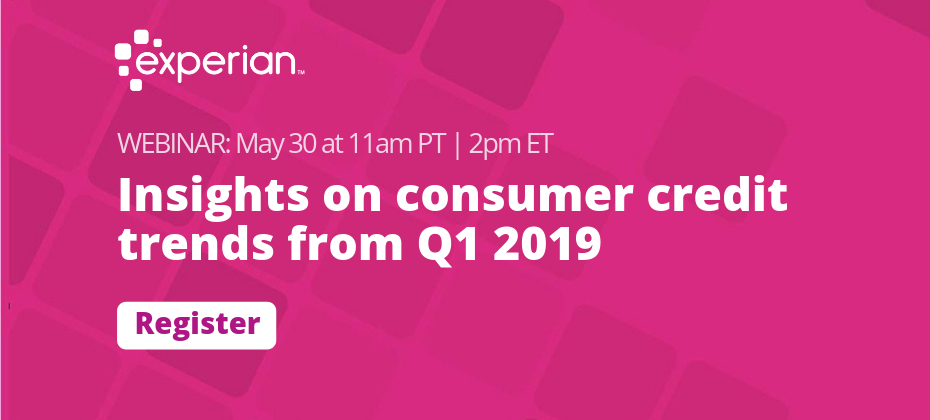Tag: credit lending

With new legislation, including the Coronavirus Aid, Relief, and Economic Security (CARES) Act impacting how data furnishers will report accounts, and government relief programs offering payment flexibility, data reporting under the coronavirus (COVID-19) outbreak can be complicated. Especially when it comes to small businesses, many of which are facing sharp declines in consumer demand and an increased need for capital. As part of our recently launched Q&A perspective series, Greg Carmean, Experian’s Director of Product Management and Matt Shubert, Director of Data Science and Modelling, provided insight on how data furnishers can help support small businesses amidst the pandemic while complying with recent regulations. Check out what they had to say: Q: How can data reporters best respond to the COVID-19 global pandemic? GC: Data reporters should make every effort to continue reporting their trade experiences, as losing visibility into account performance could lead to unintended consequences. For small businesses that have been negatively affected by the pandemic, we advise that when providing forbearance, deferrals be reported as “current”, meaning they should not adversely impact the credit scores of those small business accounts. We also recommend that our data reporters stay in close contact with their legal counsel to ensure they follow CARES Act guidelines. Q: How can financial institutions help small businesses during this time? GC: The most critical thing financial institutions can do is ensure that small businesses continue to have access to the capital they need. Financial institutions can help small businesses through deferral of payments on existing loans for businesses that have been most heavily impacted by the COVID-19 crisis. Small Business Administration (SBA) lenders can also help small businesses take advantage of government relief programs, like the Payment Protection Program (PPP), available through the CARES Act that provides forgiveness on up to 75% of payroll expenses and 25% of other qualifying expenses. Q: How do financial institutions maintain data accuracy while also protecting consumers and small businesses who may be undergoing financial stress at this time? GC: Following bureau recommendations regarding data reporting will be critical to ensure that businesses are being treated fairly and that the tools lenders depend on continue to provide value. The COVID-19 crisis also provides a great opportunity for lenders to educate their small business customers on their business credit. Experian has made free business credit reports available to every business across the country to help small business owners ensure the information lenders are using in their credit decisioning is up-to-date and accurate. Q: What is the smartest next play for financial institutions? GC: Experian has several resources that lenders can leverage, including Experian’s COVID-19 Business Risk Index which identifies the industries and geographies that have been most impacted by the COVID crisis. We also have scores and alerts that can help financial institutions gain greater insights into how the pandemic may impact their portfolios, especially for accounts with the greatest immediate exposure and need. MS: To help small businesses weather the storm, financial institutions should make it simple and efficient for them to access the loans and credit they need to survive. With cash flow to help bridge the gap or resume normal operations, small businesses can be more effective in their recovery processes and more easily comply with new legislation. Finances offer the support needed to augment currently reduced cash flows and provide the stability needed to be successful when a return to a more normal business environment occurs. At Experian, we’re closely monitoring the updates around the coronavirus outbreak and its widespread impact on both consumers and businesses. We will continue to share industry-leading insights to help data furnishers navigate and successfully respond to the current environment. Learn more About Our Experts Greg Carmean, Director of Product Management, Experian Business Information Services, North America Greg has over 20 years of experience in the information industry specializing in commercial risk management services. In his current role, he is responsible for managing multiple product initiatives including Experian’s Small Business Financial Exchange (SBFE), domestic and international commercial reports and Corporate Linkage. Recently, he managed the development and launch of Experian’s Global Data Network product line, a commercial data environment that provides a single source of up to date international credit and firmographic information from Experian commercial bureaus and Tier 1 partners across the globe. Matt Shubert, Director of Data Science and Modelling, Experian Data Analytics, North America Matt leads Experian’s Commercial Data Sciences Team which consists of a combination of data scientists, data engineers and statistical model developers. The Commercial Data Science Team is responsible for the development of attributes and models in support of Experian’s BIS business unit. Matt’s 15+ years of experience leading data science and model development efforts within some of the largest global financial institutions gives our clients access to a wealth of knowledge to discover the hidden ROI within their own data.

Last week, artificial intelligence (AI) made waves in the news as the Vatican and tech giants signed a statement with a set of guidelines calling for ethical AI. These ethical concerns arose as the usage of artificial intelligence continues to increase in all industries – with the market for AI technology projected to reach $190.61 billion by 2025, according to a report from MarketsandMarkets™. In the “Rome Call for Ethics,” these new principles require that AI systems must adhere to ethical AI guidelines to protect basic human rights. The doctrine says AI must be developed with a focus on protecting and serving humanity, and that all algorithms should be designed by the principles of transparency, inclusion, responsibility, impartiality, reliability, security and privacy. In addition, according to the document, organizations must consider the “duty of explanation” and ensure that decisions made as a result of these algorithms are explainable, transparent and fair. As artificial intelligence becomes increasingly used in many applications and ingrained into our everyday lives (facial recognition, lending decisions, virtual assistants, etc.), establishing new guidelines for ethical AI and its usage has become more critical than ever. For lenders and financial institutions, AI is poised to shape the future of banking and credit cards. AI is now being used to generate credit insights, reduce risk and make credit more widely available to more credit-worthy consumers. However, one of the challenges of AI is that these algorithms often can’t explain their reasoning or processes. That’s why AI explainability, or the methods and techniques in AI that make the results of the solution understandable by human experts, remains a large barrier for many institutions when it comes to AI adoption. The concept of ethical AI goes hand-in-hand with Regulation B of the Equal Opportunity Act (ECOA), which protects consumers from discrimination in any aspect of a credit transaction and requires that consumers receive clear explanations when lenders take adverse action. Adverse action letters, which are intended to inform consumers on why their credit applications were denied, must be transparent and incorporate reasons on why the decision was made – in order to promote fair lending. While ethical AI has made recent headlines, it’s not a new concept. Last week’s news highlights the need for explainability best practices for financial institutions as well as other organizations and industries. The time is now to implement these guidelines into algorithms and business processes of the present and future. Join our upcoming webinar as Experian experts dive into fair lending with ethical and explainable AI. Register now

Today is National Fintech Day – a day that recognizes the ever-important role that fintech companies play in revolutionizing the customer experience and altering the financial services landscape. Fintech. The word itself has become synonymous with constant innovation, agile technology structures and being on the cusp of the future of finance. Fintech challengers are disrupting existing financial models by leveraging data, advanced analytics and technology – both inspiring traditional financial institutions in their digital transformation strategies and giving consumers access to a variety of innovative financial products and services. But to us at Experian, National Fintech Day means more than just financial disruption. National Fintech Day represents the partnerships we have carefully fostered with our fintech clients to drive financial inclusion for millions of people around the globe and provide consumers with greater control and more opportunities to access the quality credit they deserve. “We are actively seeking out unresolved problems and creating products and technologies that will help transform the way businesses operate and consumers thrive in our society. But we know we can’t do it alone,” said Experian North American CEO, Craig Boundy in a recent blog article on Experian’s fintech partnerships. “That’s why over the last year, we have built out an entire team of account executives and other support staff that are fully dedicated to developing and supporting partnerships with leading fintech companies. We’ve made significant strides that will help us pave the way for the next generation of lending while improving the financial health of people around the world.” At Experian, we understand the challenges fintechs face – and our real-world solutions help fintech clients stay ahead of constantly changing market conditions and demands. “Experian’s pace of innovation is very impressive – we are helping both lenders and consumers by delivering technological solutions that make the lending ecosystem more efficient,” said Experian Senior Account Executive Warren Linde. “Financial technology is arguably the most important type of tech out there, it is an honor to be a part of Experian’s fintech team and help to create a better tomorrow.” If you’d like to learn more about Experian’s fintech solutions, visit us at Experian.com/Fintech.

You’ve Got Mail! Probably a lot of it. Birthday cards from Mom, a graduation announcement from your third cousin’s kid whose name you can’t remember and a postcard from your dentist reminding you you’re overdue for a cleaning. Adding to your pile, are the nearly 850 pieces of unsolicited mail Americans receive annually, according to Reader’s Digest. Many of these are pre-approval offers or invitations to apply for credit cards or personal loans. While many of these offers are getting to the right mailbox, they’re hitting a changing consumer at the wrong time. The digital revolution, along with the proliferation and availability of technology, has empowered consumers. They now not only have access to an abundance of choices but also a litany of new tools and channels, which results in them making faster, sometimes subconscious, decisions. Three Months Too Late The need to consistently stay in front of customers and prospects with the right message at the right time has caused a shortening of campaign cycles across industries. However, for some financial institutions, the customer acquisition process can take up to 120 days! While this timeframe is extreme, customer prospecting can still take around 45-60 days for most financial institutions and includes: Bureau processing: Regularly takes 10-15 days depending on the number of data sources and each time they are requested from a bureau. Data aggregation: Typically takes anywhere from 20-30 days. Targeting and selection: Generally, takes two to five days. Processing and campaign deployment: Usually takes anywhere from three days, if the firm handles it internally, or up to 10 days if an outside company handles the mailing. A Better Way That means for many firms, the data their customer acquisition campaigns are based off is at least 60 days old. Often, they are now dealing with a completely different consumer. With new card originations up 20% year-over-year in 2019 alone, it’s likely they’ve moved on, perhaps to one of your competitors. It’s time financial institutions make the move to a more modern form of prospecting and targeting that leverages the power of cloud technology, machine learning and artificial intelligence to accelerate and improve the marketing process. Financial marketing systems of the future will allow for advanced segmentation and targeting, dynamic campaign design and immediate deployment all based on the freshest data (no more than 24-48 hours old). These systems will allow firms to do ongoing analytics and modeling so their campaign testing and learning results can immediately influence next cycle decisions. Your customers are changing, isn’t it time the way you market to them changes as well?

Consumer credit trends and markets are constantly evolving, particularly when it comes to originations and delinquencies on mortgages, credit cards and auto loans. According to Experian research, over 2.7 million out of 89 million active automotive loans and leases are either 30 or 60 days delinquent. Triggers that signal a greater likelihood of consumers falling delinquent on loans, mortgages and credit card payments, include high-interest rates, a high utilization rate and recent derogatory trades. By tracking and forecasting consumer trends over time, you can more easily predict consumer behavior and better prepare for potential issues within each market. Join Gavin Harding, Experian Senior Business Consultant, and Alan Ikemura, Experian Data Analytics Senior Product Manager, during our live Quarterly Credit Trends webinar on May 30 at 2:00 p.m. ET. Our expert speakers will provide a view of the real estate market and share insights on the latest consumer credit trends. Highlights include: 2019 economic drivers Q1 2019 origination and delinquency trends Mortgage Home equity Bankcard Auto Register now

Today’s consumer lending environment is more dynamic and competitive than ever, with renewed focus on personal loans, marketplace lending and the ever-challenging credit card market. One of the significant learnings from the economic crisis is how digging deeper into consumer credit data can help provide insights into trending behavior and not just point-in-time credit evaluation. For example, I’ve found consumer trending behavior to be very powerful when evaluating risks of credit card revolvers versus transactors. However, trended data can come with its own challenges when the data isn’t interpreted uniformly across multiple data sources. To address these challenges, Experian® has developed trended attributes, which can provide significant lift in the development of segmentation strategies and custom models. These Trended 3DTM attributes are used effectively across the life cycle to drive balance transfers, mitigate high-risk exposure and fine-tune strategies for customers near score cutoffs. One of the things I look for when exploring new trended data is the ability to further understand payment velocity. These characteristics go far beyond revolver and transactor flags, and into the details of consumer usage and trajectory. As illustrated in the chart, a consumer isn’t easily classified into one borrowing persona (revolver, transactor, etc.) or another — it’s a spectrum of use trends. Experian’s Trended 3D provides details needed to understand payment rates, slope of balance growth and even trends in delinquency. These trends provide strong lift across all decisioning strategies to improve your business performance. In recent engagements with lenders, new segmentation tools and data for the development of custom models is at the forefront of the conversation. Risk managers are looking for help leveraging new modeling techniques such as machine learning, but often have challenges moving from prior practices. In addition, attribute governance has been a key area of focus that is addressed with Trended 3D, as it was developed using machine learning techniques and is delivered with the necessary documentation for regulatory conformance. This provides an impressive foundation, allowing you to integrate the most advanced analytics into your credit decisioning. Alternative data isn’t the only source for new consumer insights. Looking at the traditional credit report can still provide so much insight; we simply need to take advantage of new techniques in analytics development. Trended attributes provide a high-definition lens that opens a world of opportunity.

The desire to return to portfolio growth is a clear trend in mature credit markets, such as the US and Canada. Historically, credit unions and banks have driven portfolio growth with aggressive out-bound marketing offers designed to attract new customers and members through loan acquisitions. These offers were typically aligned to a particular product with no strategy alignment between multiple divisions within the organization. Further, when existing customers submitted a new request for credit, they were treated the same as incoming new customers with no reference to the overall value of the existing relationship. Today, however, financial institutions are looking to create more value from existing customer relationships to drive sustained portfolio growth by increasing customer retention, loyalty and wallet share. Let’s consider this idea further. By identifying the needs of existing customers and matching them to individual credit risk and affordability, effective cross-sell strategies that link the needs of the individual to risk and affordability can ensure that portfolio growth can be achieved while simultaneously increasing customer satisfaction and promoting loyalty. The need to optimize customer touch-points and provide the best possible customer experience is paramount to future performance, as measured by market share and long-term customer profitability. By also responding rapidly to changing customer credit needs, you can further build trust, increase wallet share and profitably grow your loan portfolios. In the simplest sense, the more of your products a customer uses, the less likely the customer is to leave you for the competition. With these objectives in mind, financial organizations are turning towards the practice of setting holistic, customer-level credit lending parameters. These parameters often referred to as umbrella, or customer lending, limits. The challenges Although the benefits for enhancing existing relationships are clear, there are a number of challenges that bear to mind some important questions to consider: · How do you balance the competing objectives of portfolio loan growth while managing future losses? · How do you know how much your customer can afford? · How do you ensure that customers have access to the products they need when they need them · What is the appropriate communication method to position the offer? Few credit unions or banks have lending strategies that differentiate between new and existing customers. In the most cases, new credit requests are processed identically for both customer groups. The problem with this approach is that it fails to capture and use the power of existing customer data, which will inevitably lead to suboptimal decisions. Similarly, financial institutions frequently provide inconsistent lending messages to their clients. The following scenarios can potentially arise when institutions fail to look across all relationships to support their core lending and collections processes: 1. Customer is refused for additional credit on the facility of their choice, whilst simultaneously offered an increase in their credit line on another. 2. Customer is extended credit on a new facility whilst being seriously delinquent on another. 3. Customer receives marketing solicitation for three different products from the same institution, in the same week, through three different channels. Essentials for customer lending limits and successful cross-selling By evaluating existing customers on a periodic (monthly) basis, financial institutions can assess holistically the customer’s existing exposure, risk and affordability. By setting customer level lending limits in accordance with these parameters, core lending processes can be rendered more efficient, with superior results and enhanced customer satisfaction. This approach can be extended to consider a fast-track application process for existing relationships with high value, low risk customers. Traditionally, business processes have not identified loan applications from such individuals to provide preferential treatment. The core fundamentals of the approach necessary for the setting of holistic customer lending (umbrella) limits include: · The accurate evaluation of credit and default risk · The calculation of additional lending capacity and affordability · Appropriate product offerings for cross-sell · Operational deployment Follow my blog series over the next few months as we explore the essentials for customer lending limits and successful cross-selling.

I love a good analogy, and living in Southern California, lately I’ve been thinking a lot about earthquakes, and how lenders might want to start thinking like seismologists when considering the risk levels in their portfolios. Currently, scientists that study earthquakes review mountains of data around fault movement, tidal forces, even animal behavior, all in an attempt to find a concrete predictor of ‘the big one’. Small tremors are inputs, but the focus is on predicting and preparing for the large shock and impact of large earthquakes. Credit risk modeling, conversely, seems to focus on predicting the tremors, (risk scores that predict the risk of individual default) and less so the large-shock risk to the portfolio. So what are lenders doing to forecast ‘the big one’? Lenders are building sophisticated models that contemplate the likelihood of the big event – developing risk models and econometric models that look at loan repayment, house prices, unemployment rates – all in an attempt to be ahead of the credit version of ‘the big one’. This type of model and perspective is at a nascent stage for many lenders, but like the issues facing the people of Southern California, preparing for the big-one is an essential part of every lender’s planning in today’s economy.

By: Staci Baker As we approach the end of the year, and the beginning of holiday spending, consumers are looking at their budgets to determine what level of spending they can do this holiday season, or if they will need additional credit for those much wanted gifts. With that in mind, it is a great time for lenders to evaluate their portfolios to determine which consumers are the best credit risks. According to the National Retail Federation, consumer spending will be up 2.1% for the 2010 holiday season. Although still at pre-recession levels, consumer confidence is starting to re-bound. But, with an increase in consumer confidence, how will lenders meet the demand for credit, and determine the credit worthiness of potential applicants? Since the beginning of the recession there has been a demand for tools that will assist lenders in managing credit risk. One such tool is the tri-bureau VantageScore, a scoring model that is highly accurate, offers greater predictiveness, and is able to score more people. Scoring models allow lenders to predict the likelihood a consumer will default on a loan. Determining who is a qualified candidate through scoring models is only part of the equation. Each lender needs to determine what level of risk to take, and what is the cost of the credit per applicant. By assessing credit risk, having a good plan in place and knowing who the target customer is, lenders will be more prepared for the holiday season. ___________________ National Retail Federation, http://www.nrf.com/modules.php?name=News&op=viewlive&sp_id=1016

When reviewing offers for prospective clients, lenders often deal with a significant amount of missing information in assessing the outcomes of lending decisions, such as: Why did a consumer accept an offer with a competitor? What were the differentiating factors between other offers and my offer, i.e. what were their credit score trends? What happened to consumers that we declined? Do they perform as expected or better than anticipated? What were their credit risk models? While lenders can easily understand the implications of the loans they have offered and booked with consumers, they often have little information about two important groups of consumers: 1. Lost leads: consumers to whom they made an offer but did not book 2. Proxy performance: consumers to whom financing was not offered, but where the consumer found financing elsewhere. Performing a lost lead analysis on the applications approved and declined, can provide considerable insight into the outcomes and credit performance of consumers that were not added to the lender’s portfolio. Lost lead analysis can also help answer key questions for each of these groups: How many of these consumers accepted credit elsewhere? What were their credit attributes? What are the credit characteristics of the consumers we're not booking? Were these loans booked by one of my peers or another type of lender? What were the terms and conditions of these offers? What was the performance of the loans booked elsewhere? Who did they choose for loan origination? Within each of these groups, further analysis can be conducted to provide lenders with actionable feedback on the implications of their lending policies, possibly identifying opportunities for changes to better fulfill lending objectives. Some key questions can be answered with this information: Are competitors offering longer repayment terms? Are peers offering lower interest rates to the same consumers? Are peers accepting lower scoring consumers to increase market share? The results of a lost lead analysis can either confirm that the competitive marketplace is behaving in a manner that matches a lender’s perspective. It can also shine a light into aspects of the market where policy changes may lead to superior results. In both circumstances, the information provided is invaluable in making the best decision in today’s highly-sensitive lending environment.